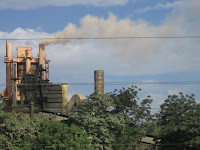The hostel is an eerie quiet with all most everyone having gone home for Diwali. With too many people around you are sucked into a kind of humdrum existence and it’s only once you’re alone does one have time to think and introspect. Here on one such day I present to you a travelogue of my trip to Agumbe.
I left here (college) late on the evening of Friday the 29th of October accompanied by three of my friends. We boarded a local passenger train to a place called Palakkad (also known as Palghat or the Gateway to Kerala). Palakkad is the first major town in Kerala whilst entering it from Tamil Nadu and incidentally it’s a place I call home too (besides Delhi of course). After supper at Palakkad, we boarded the West Coast Express at the Palakkad Junction railway station and reached Mangalore Central Railway station early on Saturday morning (5:30 am). From there we caught a bus which took us to a town called Udupi which is situated about sixty kilometres to the north of Mangalore. Udupi is a town famous for its excellent South Indian food and especially, its sweet sambar. Unfortunately we could not partake in the luxury of a delicious breakfast at Udupi as we were pressed for time. After a quick bite we headed off to Agumbe.
To put things in a better perspective Agumbe is sixty kilometres from Udupi. After completing two thirds of the journey we crossed the village of Hebri and ascended into a very steep climb with a series of tight hair pin bends. On surviving three quarters of hour on the hilly road we finally reached the village of Agumbe. Upon reaching Agumbe we headed off to the Agumbe Rainforest Research Station (ARRS) base camp.(http://maps.google.co.in/maps/ms?ie=UTF8&msa=0&msid=107726479902280188831.000495433acb4d1b03288&ll=13.151702,75.333252&spn=1.136657,2.705383&z=9)
The ARRS was set up in 2005 by the renowned herpetologist Romulus Witaker. Agumbe is known for its high density or snakes and is also known by its apt sobriquet, ‘The Cherrapunji of the South’. On an average it records the second highest rainfall in India. Incidentally the filming for the famous tv series on the ‘Malgudi Days’ was done at Agumbe.
After a slight detour where I lead my friends astray, we finally reached the ARRS at around a half past eleven. We met a few of the researchers out there and understood what kind of research work is being undertaken at the centre. We learnt about the King Cobra telemetry project aimed at understanding the habits of Kings and how they are evolving in order to survive co-habitation with humans. A project to learn about burrowing habits of scorpions (how long they burrow, why they burrow etc). Besides these projects we also learnt and discussed about various other projects including, some studying the Seetanadi River, the amphibian bio-diversity, weather monitoring to understand the impacts of climate change et cetera.
We observed a project aimed at studying as to why Flying Lizards (Draco dussumieri) show FSSD (Female-Biased Sexual Skewed Dimorphism); i.e. females are larger than the males. This phenomenon is quite rare in lizard species. (http://en.wikipedia.org/wiki/Draco_dussumieri). We spent a good three quarter of an hour with the researcher studying lizard behaviour by observing the habits of a courting lizard pair. We then went about exploring the base camp and searching for snakes around the base camp for a couple of hours; in the end all we found was just a Green Vine snake.
From the base camp we went to a waterfall called the Jog Gundi falls. After spending five minutes there, our auto driver told us about another waterfall called the Onake Abbe falls (pronounced Onkebee). ‘Onake’ means a pounding stick which is used to pound grains in villages. The falls look like a thin stick falling from up above. Our auto driver warned us about a two and a half kilometre trek with an abundance of leeches. This warning just wasn’t enough to prepare us for what was to come, neither the leeches nor the sheer beauty of the waterfalls. Enduring the wrath of these blood sucking creatures was well worth it because of the sublime and picturesque sight from the top if the falls. Standing two feet away from the precipice with the whole valley below you gives you a feeling that nothing else can compare with. What we thought as five minutes of gazing into the valley below actually turned out to be an hour. That by far exceeded our original intention of spending a quarter of an hour at the falls.
By now it was five in the evening and we decided it was time to head back to the main road in order to reach the Sunset point in time for the sunset. Imagine a sunset at the highest point on a mountain with a sun setting into the sea (Arabian Sea) at the horizon. Below you are forests as far as the eye can see and the sky is dotted with approaching clouds; a harbinger of rain later in the evening. The sun looks a majestic red orb and its rays are interspersed with the clouds painting the sky like a work of art that can be equalled by none. Such was the sunset at Agumbe.
It broke my heart to leave, but my friends at friends at Manipal awaited my arrival and so the departure had to be made. I left with a promise that someday I’d be back at Agumbe maybe working at the ARRS on a research project (a butterfly biodiversity or a snake mapping project perhaps). Until that day comes I must remain content dreaming about the majestic Agumbe sunset I once saw.
For the photographs of this visit please visit http://www.facebook.com/album.php?aid=302861&id=653528713&l=2fe05cf61a
P.P.S You could click on the photographs to get a better look at them. Except one photograph none of the pictures below were taken on this trip. To have a look at the photographs taken on this trip please click on the above mentioned link.



























